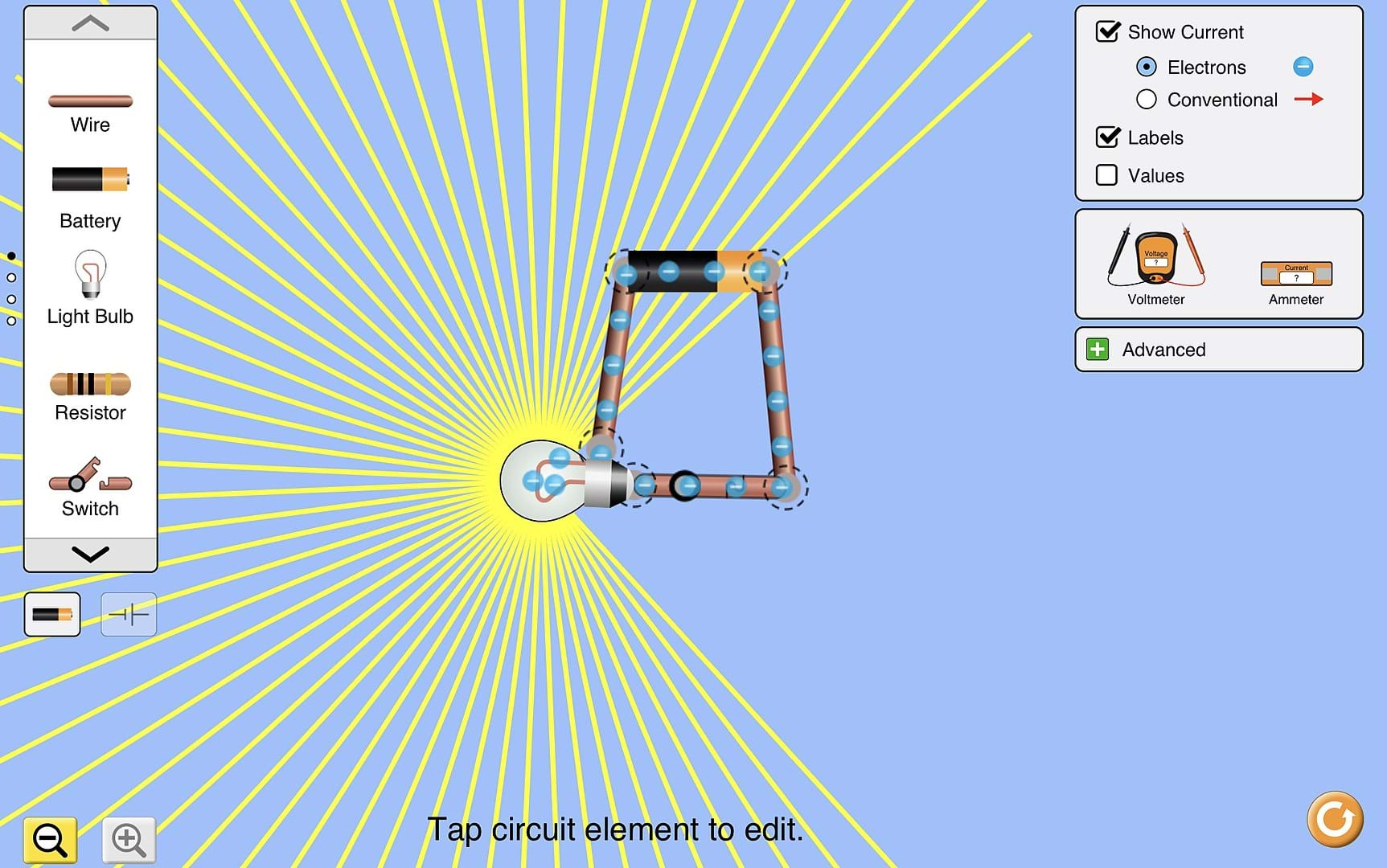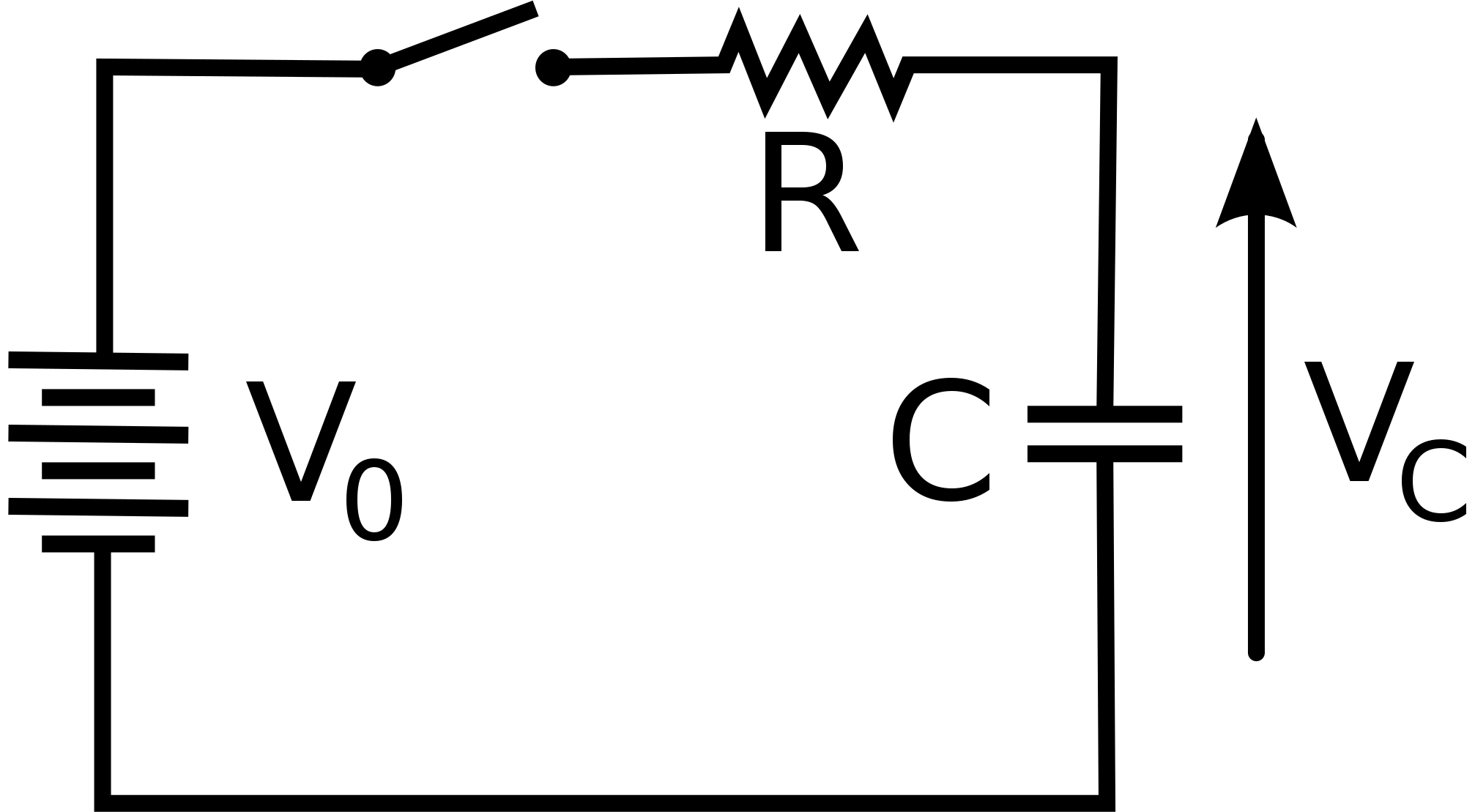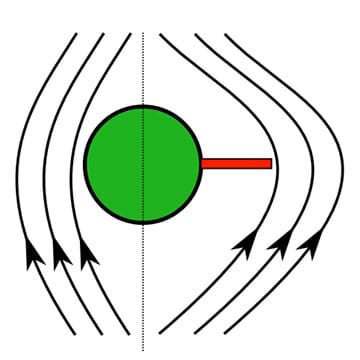Quick Look
Grade Level: 11 (10-12)
Time Required: 2 hours 45 minutes
(two 80-minute class periods)
Expendable Cost/Group: US $0.00 (Internet access is required for the activity.)
Group Size: 1
Activity Dependency: None
Subject Areas: Physical Science, Physics, Reasoning and Proof, Science and Technology

Summary
Students learn about the nature of resistors and capacitors and how they are used in circuits to observe the application of Coulomb’s law. Students review the nature of voltage divider circuits which use resistors in series and parallel circuits to vary the voltage and RC circuits in series and parallel which add capacitors to the circuits. Lastly, students study the nature of capacitors in relation to Coulomb’s Law using the PhET simulation, Capacitor Lab: Basics.Engineering Connection
Students may not know what goes on behind the walls of their world and engineering design reveals the workings of that unseen world forming schematics for their understanding. Real life uses for RC circuits impacts people who are sitting in their car using their windshield wipers or waiting on a traffic light to change. The very heartbeat of a pacemaker wearer depends on the circuit design of RC circuits. The battery-operated world exists because of RC circuits.
Learning Objectives
After this activity, students should be able to:
- Use the PhET simulation Circuit Construction Kit: AC to design and test simple voltage divider series and parallel circuits.
- Identify the components in an RC circuit.
- Compare the behaviors of series and parallel RC circuits.
- Construct and test an RC circuit using the PhET simulation.
- Describe the nature of capacitors.
- Describe the nature of resistors.
Educational Standards
Each TeachEngineering lesson or activity is correlated to one or more K-12 science,
technology, engineering or math (STEM) educational standards.
All 100,000+ K-12 STEM standards covered in TeachEngineering are collected, maintained and packaged by the Achievement Standards Network (ASN),
a project of D2L (www.achievementstandards.org).
In the ASN, standards are hierarchically structured: first by source; e.g., by state; within source by type; e.g., science or mathematics;
within type by subtype, then by grade, etc.
Each TeachEngineering lesson or activity is correlated to one or more K-12 science, technology, engineering or math (STEM) educational standards.
All 100,000+ K-12 STEM standards covered in TeachEngineering are collected, maintained and packaged by the Achievement Standards Network (ASN), a project of D2L (www.achievementstandards.org).
In the ASN, standards are hierarchically structured: first by source; e.g., by state; within source by type; e.g., science or mathematics; within type by subtype, then by grade, etc.
NGSS: Next Generation Science Standards - Science
-
CCC.1.9-12.15.
Different patterns may be observed at each of the scales at which a system is studied and can provide evidence for causality in explanations of phenomena.
(Grades 9 - 12)
More Details
Do you agree with this alignment?
-
CCC.2.9-12.11.
Systems can be designed to cause a desired effect.
(Grades 9 - 12)
More Details
Do you agree with this alignment?
-
DCI.PS2.B.9-12.2.
Forces at a distance are explained by fields (gravitational, electric, and magnetic) permeating space that can transfer energy through space. Magnets or electric currents cause magnetic fields; electric charges or changing magnetic fields cause electric fields.
(Grades 9 - 12)
More Details
Do you agree with this alignment?
State Standards
Texas - Science
-
design and construct both series and parallel circuits and calculate current, potential difference, resistance, and power of various circuits;
(Grades
9 -
12)
More Details
Do you agree with this alignment?
Materials List
Each group needs:
- computer, laptop, or tablet
- digital or paper copy of the RC Circuits Worksheet for each student
- access to the PhET Simulations website at the University of Colorado Boulder
Worksheets and Attachments
Visit [www.teachengineering.org/activities/view/utep-2663-rc-circuits-electricity-current-activity] to print or download.Pre-Req Knowledge
- A basic understanding of electricity, circuits, and currents.
- Exposure to Coulomb’s law.
Introduction/Motivation
Today we are going to look at how different types of circuits accomplish the desired task. Let’s briefly review. How do series circuits work? (Answer: Series circuits allow a single path for the electricity to flow and same voltage throughout the circuit.) How do parallel circuits work? (Answer: Parallel circuits provide multiple paths and can divide the voltage across various paths.) What are Resistor-Capacitor (RC) circuits? [Answer: RC circuits have both a resistor (R) and a capacitor (C). They are often important elements in electronic devices, like windshield wipers, cell phones, heart pacemakers, etc. They also play an important role in the transmission of electrical signals in nerve cells.]
Through three sets of activities, you will learn to design various types of circuits culminating in an RC circuit.
Engineering is the search for solutions and in our electrically powered, modern world an understanding of how we control the flow of electricity matters. Circuit design allows us to control that flow. Through these activities you will start that fundamental understanding.
Procedure
Background
This activity was designed for a student without a background in electronics who was forced to take physics to graduate and did not see “science and engineering” in their future. If the “lightbulb” turns on through success in this open ended, student-driven experience, they might envision a different future. Therefore, the focus of the activity is allowing the students to be as active as possible in their learning to create meaning.
Resistor–capacitor (RC) circuits use capacitors and resistors to regulate voltage and control the current in both series and parallel circuits by the charging and discharging of the capacitor. RC circuits are used in things like pacemakers and windshield wipers.
For example, heart pacemakers use RC circuits for the timing of voltage pulses to regulate the heart beats of a malfunctioning heart. Some models of intermittent windshield wipers use a variable resistor to adjust the interval between sweeps of the wiper. By increasing the resistance in the RC circuit, the time is increased between the operation of the wipers.
Circuits are the paths that electricity can take to perform a desired task (that is, work.) Electricity can be stopped by using a switch to open and close the circuit. Electricity can be described by its various features: its voltage - its force (measured in volts), current-the rate electricity flows (measured in amps) and the resistance in the circuit - the friction it experiences (measured in ohms.) Various components can be added to the circuit to control the flow of electricity.
Examples of real-world implementations of the types of circuits in the simulations.
- Open Circuits - when a light switch turns off the lights. Switches create closed circuits when used to turn on the lights, too.
- Closed Circuits - when the microwave turns on after hitting the power button.
- Series Circuit – for example, cheap string lights: when one light goes out all the lights go out.
- Parallel Circuit - the electrical system over your entire home. Different things can be turned off and other things turned on all at the same time.
- RC Circuits - the RC circuits are used for timing the switching off/on of the intermittent windshield wipers on vehicles and in pacemakers.
Before the Activity
- Familiarize yourself with the activity by reading the Activity Narrative for Instructors.
- Make copies or provide digital access to the RC Circuits Worksheet (1 per student or pair)
- Make copies of the RC Circuits Pre/Post-Quiz (1 per student)
- Be familiar with the PhET simulations used in the activities
With Students
- Have each student complete the RC Circuits Pre/Post-Quiz.
- Go through the Introduction and Motivation section with the students.
- Have students (individually or in pairs) set up their computers/laptops/tablets and access the internet.
- Provide a digital or paper copy of the RC Circuits Worksheet to each student or student pair.
- Tell the students that they will design and test various circuits to fit the engineering constraints of each of the following activities and verify the expected relationships between voltage and current graphically.

We can understand how circuits work through graphical representations. - Have students work through Part 1: Pre-Activity on the worksheet.
- Instruct the students to work through Engineering Challenge 1: Single (series) circuit. The instructions for the activity are on the worksheet. The students use this simulation to design the circuits described in each of the engineering challenges: https://phet.colorado.edu/sims/html/circuit-construction-kit-ac/latest/circuit-construction-kit-ac_en.html (Note: Allow students to construct their understanding of the concepts and develop their skills by providing enough time for each activity.)
- After enough time, guide the students to start the second engineering challenge: Multiple path (parallel) circuit.
- After enough time, guide the students to start Part 2 and the third engineering challenge: RC circuit.
- After enough time, guide the students to start Part 3: Coulomb’s Law and Capacitors. Students use this simulation to complete Part 3: https://phet.colorado.edu/sims/html/capacitor-lab-basics/latest/capacitor-lab-basics_en.html
- Once the students have completed each simulation, make sure they fill out their worksheets.
- Have each student complete the RC Circuits Pre/Post-Quiz.
Vocabulary/Definitions
alternating current (AC): Current that alternates its direction; the form of electricity from our wall sockets
ampere: Unit of current
capacitor: Device that stores and discharges electrons
circuit: Path of electricity
closed circuit: Path that electricity can completely flow around
current: Flow of electricity
direct current (DC): Form of electricity that batteries pump out; current that only flows in one direction
ohm: Unit of resistance
open circuit: Broken path that stops electricity from flowing
parallel circuit: Circuit with multiple paths for the current to flow through
resistor: Device that hinders the flow of electricity
resistor–capacitor (RC) circuit: A circuit containing resistors and capacitors
series circuit: Circuit with only one path for the current to flow through
volt: Unit of voltage
voltage: Force that pushes the electricity through the circuit
Assessment
Pre-Activity Assessment
Pre-Quiz: Have students match the terms with their descriptions in the RC Circuits Pre/Post-Quiz.
Activity Embedded (Formative) Assessment
Worksheet /Pairs Check: Have students work individually or in pairs on the RC Circuits Worksheet. After they finish, have them compare answers with a peer or another pair, giving all students time to finish the worksheet.
Post-Activity (Summative) Assessment
Post-Quiz: Re-administer the RC Circuits Pre/Post-Quiz to see if there is growth.
Making Sense Assessment: Have students reflect on the science concepts they explored and/or the science and engineering skills they used by completing the Making Sense Assessment.
Troubleshooting Tips
The use of the meters and the production of the graphs may be difficult for students. Have them change settings or location of probes. Confirm that students are reading the procedure correctly.
Activity Extensions
Have students research the development and history of windshield wipers and the pacemaker.
Activity Scaling
For younger students or students who need support, eliminate the graphing portion or provide schematics or partial schematics for building the series and parallel circuits.
Additional Multimedia Support
These activities require the following resource:
Subscribe
Get the inside scoop on all things TeachEngineering such as new site features, curriculum updates, video releases, and more by signing up for our newsletter!More Curriculum Like This

Students are introduced to several key concepts of electronic circuits. They learn about some of the physics behind circuits, the key components in a circuit and their pervasiveness in our homes and everyday lives.

Students learn that charge movement through a circuit depends on the resistance and arrangement of the circuit components. In one associated hands-on activity, students build and investigate the characteristics of series circuits. In another activity, students design and build flashlights.

Students learn about nondestructive testing, the use of the finite element method (systems of equations) and real-world impacts, and then conduct mini-activities to apply Maxwell’s equations, generate currents, create magnetic fields and solve a system of equations. They see the value of NDE and FEM...

Students imagine they are stranded on an island and must create the brightest light possible with the meager supplies they have on hand in order to gain the attention of a rescue airplane. In small groups, students create circuits using items in their "survival kits" to create maximum voltage, measu...
Copyright
© 2023 by Regents of the University of Colorado; original © 2021 University of Texas El PasoContributors
Lisa RothSupporting Program
Project ACE: Action for Equity, University of Texas El PasoAcknowledgements
Project ACE was made possible by a Science Education Partnership Award (SEPA) award no. 1R25GM132959-01A1 from the National Institute of General Medical Sciences and the National Institutes of Health under the Texas Instruments Foundation Professorship in Electrical Engineering at the University of Texas El Paso. Any opinions, findings, and conclusions or recommendations expressed in this material are those of the authors and do not necessarily reflect the views of the National Science Foundation or any other funding agencies.
Last modified: March 16, 2023









User Comments & Tips